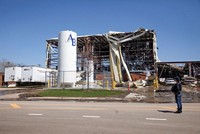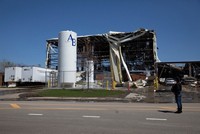Advertisement
Grab your lab coat. Let's get started
Welcome!
Welcome!
Create an account below to get 6 C&EN articles per month, receive newsletters and more - all free.
It seems this is your first time logging in online. Please enter the following information to continue.
As an ACS member you automatically get access to this site. All we need is few more details to create your reading experience.
Not you? Sign in with a different account.
Not you? Sign in with a different account.
ERROR 1
ERROR 1
ERROR 2
ERROR 2
ERROR 2
ERROR 2
ERROR 2
Password and Confirm password must match.
If you have an ACS member number, please enter it here so we can link this account to your membership. (optional)
ERROR 2
ACS values your privacy. By submitting your information, you are gaining access to C&EN and subscribing to our weekly newsletter. We use the information you provide to make your reading experience better, and we will never sell your data to third party members.
Industrial Safety
Chemical Safety Board to require accident reporting
Companies will have 8 hours to file a brief report
by Jeff Johnson, special to C&EN
February 10, 2020

Operators of chemical companies, refineries, and other facilities that experience a significant chemical accident must report the incident to the US Chemical Safety and Hazard Investigation Board within 8 hours, under a long-delayed regulation issued Feb. 5.
“The rule requires prompt reports to the CSB from owners or operators of facilities that experience an accidental release” of a regulated or extremely hazardous substance that results in death, serious injury, or substantial property damage, says CSB Interim Executive Kristen Kulinowski in a statement.
“The CSB anticipates that these reports will provide the agency with key information important to the CSB in making prompt deployment decisions,” she says. Although hundreds of accidents a year might qualify for investigation, the agency has the resources to investigate only a few.
Previously, to determine which accidents to pursue, the CSB has relied primarily on media reports and information collected by the National Response Center, a database maintained by the US Coast Guard. After the CSB released its draft reporting rule for public comment, it received feedback from several industry organizations urging the agency to continue to rely on response center information rather than require new reports.
However, the CSB found the response center data to be inadequate. It examined 1,923 incidents that occurred over a 10-year period and met its investigation criteria. CSB found the center identified only 13% of these incidents.
In all, some 43 individuals and others commented on the rule’s proposal, according to the CSB. Some urged the CSB to require companies to provide more detail in reports and to correct them as necessary. However, the CSB noted the reports are intended only to help determine the importance of the accident and whether it should merit deployment and investigation.
Several organizations also urged the CSB to make the company reports easily accessible to the public. The CSB responded that public release is restricted by other federal statutes, and consequently the company reports can only be obtained through Freedom of Information Act requests. CSB investigation reports are freely available to the public.
The CSB, however, agreed with some commenters that the amount of time allowed between when an accident occurs and when the CSB must be informed was too short. The CSB increased that window from 4 to 8 hours in the final regulation.
The legislation that created the CSB in 1990 required the agency to create a reporting regulation such as the one now finalized. The board had discussed creating the regulation but never followed through to implement one. Environmental and community groups finally sued the board. In February 2019, a US District Court judge ordered the agency to finalize a rule within a year. The regulation will go into effect 30 days after it is published in the Federal Register, which is expected to happen the week of Feb. 10.







Join the conversation
Contact the reporter
Submit a Letter to the Editor for publication
Engage with us on Twitter